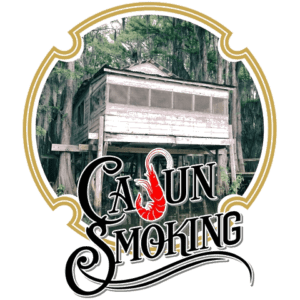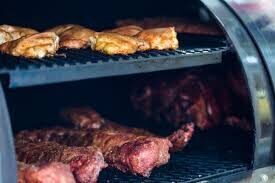Cajun Smoked Meats
Cajun smoked meats refer to a method of cooking mixed with a blend of Cajun spices. A Cajun smoked meat is a flavor enriched meat that has been cooked low and slow. The smoke adds a delicious, savory flavor that you get by using this cooking method. The Cajun flared flavor comes from mouthwatering, aromatic blend of spices and herbs that have been infused onto or into your smoked meats.
Cajun Smoking
The term smoking is used loosely as a universal term. It is also thousands of years old, dating back to the paleolithic era. Most people prefer to say ‘smoke’ rather than grill, barbecue, oven roast, etc. These methods are all quite different. However, ‘smoked’ is a term used for the low and slow process of preserving and flavoring meat.
Ever hear of the Maillard reaction? The Maillard reaction is a chemical reaction between amino acids and reducing sugars that gives browned food its distinct flavor. This is what creates the outpouring of nostril filling aromas.
Smoking can take all day and possibly all night depending on the size and quantity of the meat that you are smoking. Why? Indirect heat, that’s why, this is where the magic happens. The meat is not placed directly on top of the flame or heat source. It is placed indirectly, sometimes even in a different chamber. You want the heat and the smoke to drift around the meat for optimal absorption. One key to this perfection is a well-crafted smoker designed to ensure that the smoke and heat circulate properly for an even cook.
In case you are wondering, here’s a quick run through of what the differences are between smoking, grilling, and barbecuing.
- Smoking is perfected through almost no heat or low heat ranging from 52 to 140 ◦F (12 to 60 ◦C). Then, the meat is cooked slowly over a long period of time.
- Grilling is perfected through high temps such as 500 ◦F (200 ◦C). It traps the juices quickly much like searing by creating a crust on the outside of the meat. Searing is done above the heat like in a skillet whereas grilling, like broiling, where the heat or open flame cooks the meat quickly sealing in the juices.
- Barbecuing is perfected through low temps ranging from 200 to 300 ◦F (93 to 150 ◦C). Barbecuing means to roast, broil or grill meat over live coals or an open fire. Often these meats are basted with a seasoned sauce.
There are 3 types of Cajun smoking methods: cold, warm, or hot. Depending on your choice of method will depend on the temperature needed.
- Cold smoking is typically done between 68 to 86 ◦F (20 to 30 ◦C). This method does not cook the food, it is used mainly to enhance the ‘smoke’ flavor. Preferred foods for this method are cheeses, nuts chicken, beef, pork chops, salmon, scallops, and steak. Often these meats are hung in a dry place to develop a pellicle or a coat of proteins which helps the smoke flavor to cling to the outer layer of the meats. According to the US National Center for Home Food Preservation, to ensure safety, cold smoking is not something that should be attempted at home but by a person certified in HACCP (Hazard Analysis Critical Control Points).
- Warm smoking is typically done between 77 to 104 ◦F (25 to 40 ◦C). Simply, light a fire with your choice of fuel and maintain the temperature until the meat is cooked thoroughly. To check the thoroughness, you may want to invest in a meat thermometer.
- Hot smoking is typically done between 126 to 176 ◦F (52 to 80 ◦C). Foods cooked at these temperatures will be fully cooked after a certain amount of time, depending on the size and quantity of the meat. Keeping the temperature below 185 ◦F (85 ◦C) will ensure less shrinkage, buckling or even splitting of the meats, which will result in less serving portions.
How To Smoke
Scientifically, denaturing is the term used for the physical and chemical changes that take place when smoking meats. While it is a complex process, it’s just basically when the protein loses its structure and the meat turns brown.
- First, start with your meat. One would think that you’d choose a high-quality meat. However, a cheaper, fattier, or tougher cut works best because these cuts render into juicy, full of natural flavor, cooked meats. Thanks to the fattier marbling within the meat, it creates its own juices. I’d recommend using a local butcher. Here you get meat that is less likely to contain fillers. Popular cuts are brisket, pork butt, pork loins, and ribs; just to give a quick list.
- Second, you need a smoker. This is a specific type of cooking device that is constructed to house your fuel and to let the smoke drift around your food items. Can you smoke other things besides meat? Absolutely, but we’ll get into that goodness later.
- Third, you need a fuel. There are several types of fuel: wood, electric, propane, charcoal, pellets, etc. The most popular type being wood.
Step 1: Brining Your Meat
Yes, this is important because brining aids in keeping your meat from drying out during the smoking process. You want your meat to have the optimal moisture retention, therefore I highly recommend a salt brine. A salt brine makes the proteins in your meat more water-absorbent. You can soak your meats up to 10-12 hours, and right up till you start smoking.
Step 2: Start Your Fire
You want to start your fire early enough so that you raise the temperature of your entire smoker to the desired temp. I’d give it a good hour. A good rule of thumb is to maintain a nice temp between 212 to 230◦F (100 to 110 ◦C). You want the connective tissues inside your meat to hydrolyze or turn into gelatin without overheating the proteins. In other words, you want it to be melt-in-your-mouth tender. Don’t put your meats in there too soon, you may run into the risk of having to restart your fire due to various reasons such as green wood or dried out old wood which burns rather quickly.
Step 3: Place Your Meats
Place your meats into your smoker. The actual placement of your meats in a smoker really doesn’t matter too much; unless you have a large amount of meat and your smoke isn’t circulating to the far side of the smoker. In that case, you will want to check your ventilation, the amount of fire and fuel, or rearrange your meats accordingly.
Step 4: Wrap Your Meat
Once you have a wonderful smoke ring (2), wrap your meat in aluminum foil to help further protect it from drying out. For smoking, I recommend thick, heavy-duty foil, one that does not rip or tear easily.
Step 5: Maintain Fuel & Heat
Just because this is the last step doesn’t mean that it is less important. You must remember to maintain your temperature. Keep stoking your fire and adding more fuel as needed.
Cajun Twist
Let’s add to that a Cajun twist, hence Cajun smoked meats. Cajun is a style of cooking named by the French. This French style uses a heavily seasoned dark roux, a light roux, a stock or a dry or wet rub with herbs and spices. For smoked meats you will use a dry or wet rub to coat the outer layer of your meat with tasty, savorous spices. These spices range from bay leaf, parsley, leek, thyme, chives to peppers. While the ingredients may sound similar to what most people may use, the Cajun blend differs according to which spices you use for the base and the heat which accompanies these spices.
Comforting Results
If you’re looking for comfort food, look no further. Smoking produces some of the Southern’s most comforting food. The fragrant woodsy smell surrounds a home like no other. Add a Cajun flare and you have the most luscious, delectable goodness. The work that you will need to put into this smoking method will result in a well-worth it payoff.

